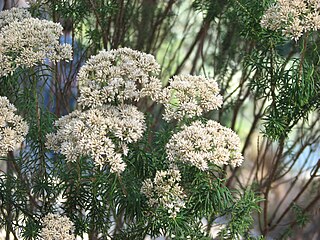
Ulmus laevisPall., variously known as the European white elm, fluttering elm, spreading elm, stately elm and, in the United States, the Russian elm, is a large deciduous tree native to Europe, from France northeast to southern Finland, east beyond the Urals into Kyrgyzstan and Kazakhstan, and southeast to Bulgaria and the Crimea; there are also disjunct populations in the Caucasus and Spain, the latter now considered a relict population rather than an introduction by man, and possibly the origin of the European population. U. laevis is rare in the UK, however its random distribution, together with the absence of any record of its introduction, has led at least one British authority to consider it native. NB: The epithet 'white' elm commonly used by British foresters alluded to the timber of the wych elm.

Cassinia is a large genus of plants in the family Asteraceae, most or all of which are native to the Southern Hemisphere. It was named for French botanist Alexandre de Cassini.

Plectropomus laevis, known commonly as the black-saddled coral grouper, cluespotted coral trout, blacksaddled coral trout, blue-spot trout, Chinese footballer, footballer cod, footballer coral trout, oceanic coral trout or tiger trout, is a species of marine ray-finned fish, a grouper from the subfamily Epinephelinae which is part of the family Serranidae, which also includes the anthias and sea basses. It is found in the Indo-Pacific region.
Major Plains is a rural locality situated to the north-west of Benalla in Victoria, Australia. It is 226 kilometres by road from Melbourne.

Cassinia aculeata, also known as common cassinia, dolly bush or dogwood, is a shrub in the family Asteraceae. The species is native to the states of South Australia, New South Wales, Victoria and Tasmania in Australia. It grows to between 1 and 2.5 metres high and has sticky, hair-covered leaves which are 10 to 30 mm long and 1 to 2 mm wide. The creamy-white flower heads appear in dense clusters from summer to autumn.

Cassinia arcuata, commonly known as drooping cassinia, biddy bush, Chinese scrub, Chinese shrub, Sifton bush and tear shrub, is a shrub species in the family Asteraceae. It is endemic to southern Australia. It grows to 2 metres high and has sticky leaves which are 40 to 15 mm long and 1.5 mm wide. The pale brown inflorescences appear in panicles from spring to autumn. Plants have a distinctive curry scent. The species colonises disturbed and cleared sites. It is native to the states of Western Australia, South Australia, New South Wales, and Victoria.

The Burrinjuck Nature Reserve is a protected nature reserve on the south west slopes of New South Wales, Australia. The 5,250-hectare (13,000-acre) reserve is located adjacent to the Burrinjuck Dam, with 5,118 hectares of the reserve located on the northern side of the reservoir, and the remaining 89 hectares located on the southern side of the reservoir to the northeast of Black Andrew Nature Reserve. It includes land formerly managed as the Burrinjuck State Forest and Burrinjuck State Recreation Area.

The Black Andrew Nature Reserve is a protected nature reserve located on the south west slopes of New South Wales, Australia. The 1,559-hectare (3,850-acre) reserve is situated on the southern shore of Burrinjuck Dam on the Murrumbidgee River, an important reservoir for the Murrumbidgee Irrigation Area.

Cassinia aureonitens, commonly known as the yellow cassinia is a plant native to eastern Australia.

Cassinia cunninghamii, commonly known as Cunninghams everlasting, is a plant native to central New South Wales in eastern Australia.
Cassinia compacta is a plant native to eastern Australia.
Cassinia uncata, commonly known as sticky cassinia, is a plant native to eastern Australia.
Cassinia adunca is a plant native to New South Wales and South Australia in eastern Australia.
Cassinia subtropica is a plant native to northern New South Wales and Queensland in eastern Australia.
Cassinia copensis is a plant native to northern New South Wales in eastern Australia.
Cassinia macrocephala is a plant native to central-northern New South Wales in eastern Australia.
Cassinia ochracea is a plant native to far southern New South Wales in eastern Australia.
Cassinia venusta is a plant native to far southern New South Wales and Victoria in eastern Australia.
Cassinia theresae is a plant native to central-western New South Wales in eastern Australia.
Protea laevis, also known as the smooth-leaf sugarbush, is a flowering shrub that belongs within the genus Protea.








